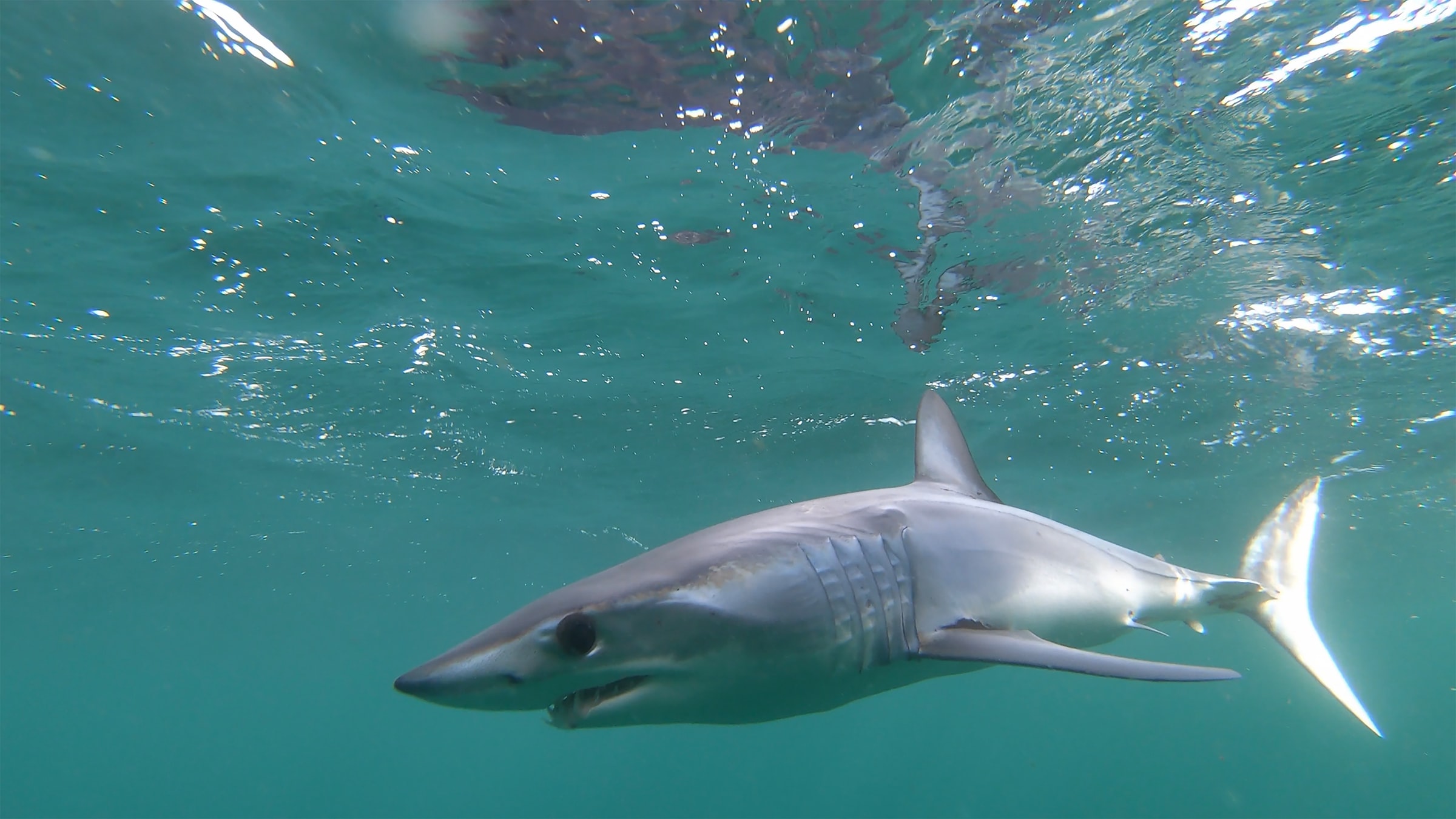The fastest shark in the ocean: the cheetah of the sea. Here you will learn what makes this sleek marvel of nature unique on the planet. You will get the background of this species’ relationship with our own.
The mako is one of the most iconic creatures on the planet, and now more than ever you need to take the chance to get to know them as they dance on the brink of extinction.
What Does A Mako Shark Look Like?
The term “mako shark” includes both the longfin mako and the shortfin mako. They have a number of subtle differences, the biggest of these being that one has longer fins and one has shorter (you can probably guess which is which).
Mako sharks look like torpedoes, with slender, streamlined bodies and a sharp, pointed snout. The sharp nose gives them a look like a miniature great white or, combined with their big eyes, like a smaller version of the blue shark. They grow up to 10-12 feet long and weigh around 1200 pounds. Females are larger than the males.
The Mako shark can be found pretty much throughout the worlds oceans, with the exception of the poles, preferring tropical to temperate climates and dwelling from the surface down to 1400 feet below. They can not survive in fresh water and live exclusively in the salt water oceans.
What Are Mako Sharks Known For?
Mako sharks are the fastest sharks in the world: they can swim at 31 miles per hour (mph) and have been reported to reach speeds beyond 60 mph! To put that in perspective, the average human swims around 2 mph; Olympic medalist Michael Phelps swims around 6 mph.
The reason why makos are so fast is because of the structure of their skin. Their flexible scales work in such a way as to reduce drag by means of something referred to as “passive bristling.” When we swim, the water is pushed to the side as wake; this wake in a sense illustrates an extra level of resistance.
The passive bristling effect of the mako scales reduces the wake, and maintains attached flow around the body, effectively reducing the resistance and increasing its swimming efficiency. This speed definitely comes in handy for them when considering their favorite prey includes such fast moving creatures as tuna (43-47 mph) and swordfish (50 mph). They have even been known to prey on sailfish, the fastest fish in the ocean at reported speeds of 60-70 mph.
Mako sharks have the unusual habit of jumping up out of the water. They can jump up to 20 feet beyond the water’s surface! We do not know why they do this, but it is a clear demonstration of their power.
Imagine yourself on the receiving end of the force needed to launch a fully grown mako shark 20 feet from the water; you just imagined how their prey feels. Mako’s are known to hunt by lunging up from beneath and ripping into the target above.
A Danger To Us Or In Danger From Us?
We do not know when mako sharks were discovered, but the first recorded description of them was in 1810 by the French polymath Constantine Samuel Rafinesque-Schmaltz, who called them by the name Isurus spallanzani.
The name Mako comes from the Maori “Mako Mako,” with the ominous meaning of “man-eater.” Naturally, this leads one to wonder: are mako sharks man eaters? The answer is: not really.
They can be aggressive, proving this by having 20 recorded attacks on boats (second only to the great white); however, there have only been 9 recorded (unprovoked) attacks on humans in the last 500 years, and only one death.
Are mako sharks dangerous? Yes. The numbers clearly show that the odds of an attack are very low, but considering it’s power and speed, this is not a fish to mess around with.
Mako sharks do worse in captivity than any other species, even the great white. Several aquariums have tried to contain them, but the sharks had an especially hard time navigating the walls and died within a few days.
In 2019 the mako shark went from being classified as vulnerable to endangered. Like all sharks, they have been a victim of over-fishing, both directly and as by-catch, and by the high demand for shark fin soup. Fisherman have specifically targeted mako sharks as a food source, as many consider them the best tasting shark meat.
Mako sharks are becoming more widely protected, but much needs to be done to prevent their extinction as they are in a highly vulnerable condition and still in high demand in certain parts of the world, such as Asia.
We do not know exactly how many mako sharks are left, but we know that even if they stopped being killed by humans today, populations would continue on a downward trend for another 15 years. They need a long time for gestation and then take a relatively long time to mature, so numbers cannot bounch back very quickly.
Conclusion
The Mako is a marvel of the natural world. It can swim at highway speeds with its uniquely structured scales; it can outrun and overpower the strongest of prey; they roam all the world’s oceans. People have hunted them to the brink of extinction for their delicious meat and accidentally killed untold numbers as by-catch while hunting tuna, our shared delicacy. They are sleek, strong, speed machines and I’m glad I got to introduce you to one of the most iconic of the sharks in our seas!
